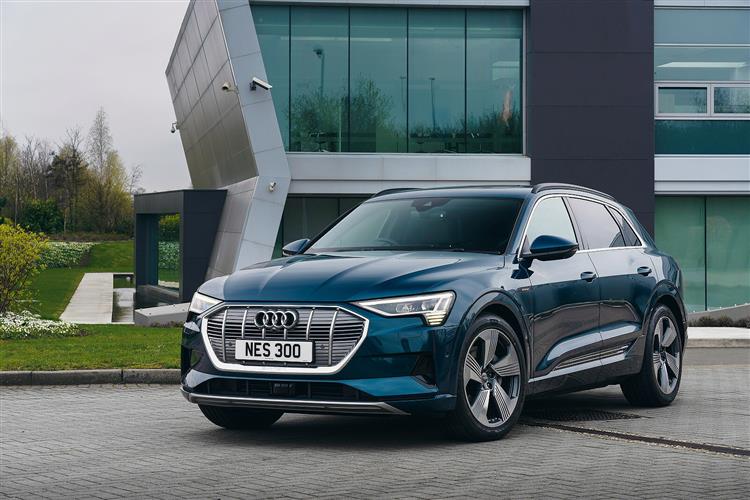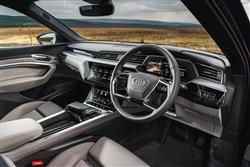INGOLSTADT'S FIRST SPARK (some text hidden) --NONE--
By Jonathan Crouch
Introductionword count: 69
Audi's first full electric car, the e-tron SUV, was promised to us back in 2019 as a technological 'tour de force'. This battery-powered large SUV took the best bits from the brand's conventional Crossovers and blended them with next-level electrification technology. The driving range lags behind period rivals, but there's a beautiful cabin and even quite engaging driving dynamics. Let's check this luxury EV out as a used buy.
Modelsword count: 8
5dr SUV (50 quattro, 55 quattro, e-tron S)
Historyword count: 447
Wisely perhaps, Audi took its time in creating its first fully electric car, Ingolstadt having sat and watched others battle with inferior battery technology. In 2019 though, it acted to try and redefine the standard in the Battery Electric Vehicle segment. The first result of the company's efforts was this car, the Audi e-tron, first launched with the conventional SUV body shape we look at here. By 2019, those familiar with the brand were already familiar with the 'e-tron' badge, most notably used on versions of the A3 and Q7 that had embellished petrol engines with plug-in technology. Those models represented a warm-up act; here though was where the company's e-tron engineering started getting serious. Cars like Jaguar's I-PACE, the Mercedes EQC, BMW's iX3 and Tesla's Model X needed to be faced by Ingolstadt's take on what a premium battery-powered electric model should be. 'EV goes Audi' was the marketing strapline here. It's convenient for automotive designers faced with electrification challenges that the market's crying out for SUVs because a Crossover's high-set practical body shape provides plenty of space to squirrel away all the necessary bulky batteries and awkwardly-shaped electric motors without these things intruding into cabin passenger space. Here, that issue was particularly pertinent because as well as a liquid-cooled lithium-ion battery pack, there were two motors to package in - a big one for the rear wheels and a smaller one for the front. The result was a powertrain that weighed almost twice as much as a conventional engine and transmission package, but one which still claimed (in the bigger-battery 95kWh 55 quattro model) to be able to deliver a 241 mile WLTP-rated driving range, though that wasn't particularly class-competitive. Still, Audi hoped that unique cabin technology would set this e-tron apart, perhaps most notably its optional 'Virtual Mirrors', 'L'-shaped pods that replaced ordinary door mirrors and transferred footage of what was happening behind to screens integrated into the doors where door handles would normally be. But that was a bit of tinsel. The important thing here was that Ingolstadt claimed to have packaged up all the elements necessary to create Tesla-style technology with more polish and panache than anything previously seen in this sector. And delivered it in a car that drives, well, like an Audi, not some kind of automotive appliance. In 2019, a separate e-tron Sportback body style followed to sell alongside the standard SUV body shape. And a few months later, a tri-motor e-tron S drivetrain was made available as a flagship option for both body styles. Both the e-tron SUV and the e-tron Sportback were replaced, respectively, by the Q8 e-tron and the Q8 Sportback e-tron models in early 2023.
What You Getword count: 517
Two e-tron body styles were offered, the Sportback or the standard SUV - which is our focus here. Either way, you'd know this was an Audi. You might not immediately recognise though, that this is an EV. Direct rivals like Jaguar's I-PACE and the Mercedes EQC intentionally deviate from brand styling expectations to emphasise their electrified remit. With the e-tron, Ingolstadt didn't feel the need to do that, though we were told that its design was just as unique. From the side, you realise why this car hides its bulk so well. It's actually almost as long as an A6 Avant estate. A nice touch is the inclusion of charging flaps on both sides of the car behind the front wheel arches. This car's actually narrower than some of its key rivals from its period, but Audi wanted you to think the opposite, hence the use of a wide LED light strip connecting the LED tail lamps, a feature of all the brand's luxury models in this period. Inside, you get a familiar Audi-style cabin complete with two central MMI touch response displays that blend into vast swathes of piano black trim. You view another screen through the four-spoke wheel, this one a 12.3-inch 'Virtual Cockpit' monitor that includes a 'Power Meter' covering the car's charging and regenerative functions. More screens can be added too, if you get a car whose original owner paid extra for Audi's clever 'Virtual exterior mirror' package, which replaces the usual exterior mirrors on each side of the car with a little camera on a stalk relaying images back to a 7-inch OLED display at the top of each front door. Anyway, enough on screens. The leather-stitched seats are superbly comfortable and position you fairly loftily - which is one of the reasons why forward vision is excellent. And there's plenty of interior storage, including a central open-sided compartment between the seats that's intended to have the feel of a light, sleek sculpture. It's unusual, much like the gear selector, which is operated by a hand rest which appears to 'float' above the console and is activated by a one-touch action conducted with either thumb or index finger. And in the rear? Well there's certainly plenty of room in the back for a couple of six-footers to get very comfortable indeed. You could say the same of a rival Jaguar I-PACE, but the rear section of the e-tron's roof doesn't curve down quite so sharply as that of the Jag, so there's less of a claustrophobic feel. The alternative Sportback body style doesn't do quite so well in this regard, but there's still plenty of headroom in the back. We'll finish with a look at cargo space. There's a 60-litre compartment under the bonnet. As for the boot area, you get a powered tailgate of course, which with the SUV body shape rises to reveal a 600-litre luggage bay which also incorporates a useful under-floor storage area. Fold down the rear bench (which folds conveniently in a 40:20:40-split) and 1,725-litres of capacity is freed up. The Sportback version's boot is 45-litres smaller.
To see the full road test text contact us on 0330 0020 227
Pictures (high res disabled)

.jpg)
|
.jpg)
|
.jpg)
| |||
.jpg)
|
.jpg)
|
.jpg)
| |||
.jpg)
|
.jpg)
|
.jpg)
| |||
.jpg)
|

|
Scoring (subset of scores)
Category: Hybrid, Plug-in, Electric & Hydrogen
| Performance | |
| Handling | |
| Comfort | |
| Space | |
| Styling, Build, Value, Equipment, Depreciation, Handling, Insurance and Total scores are available with our full data feed. | |



